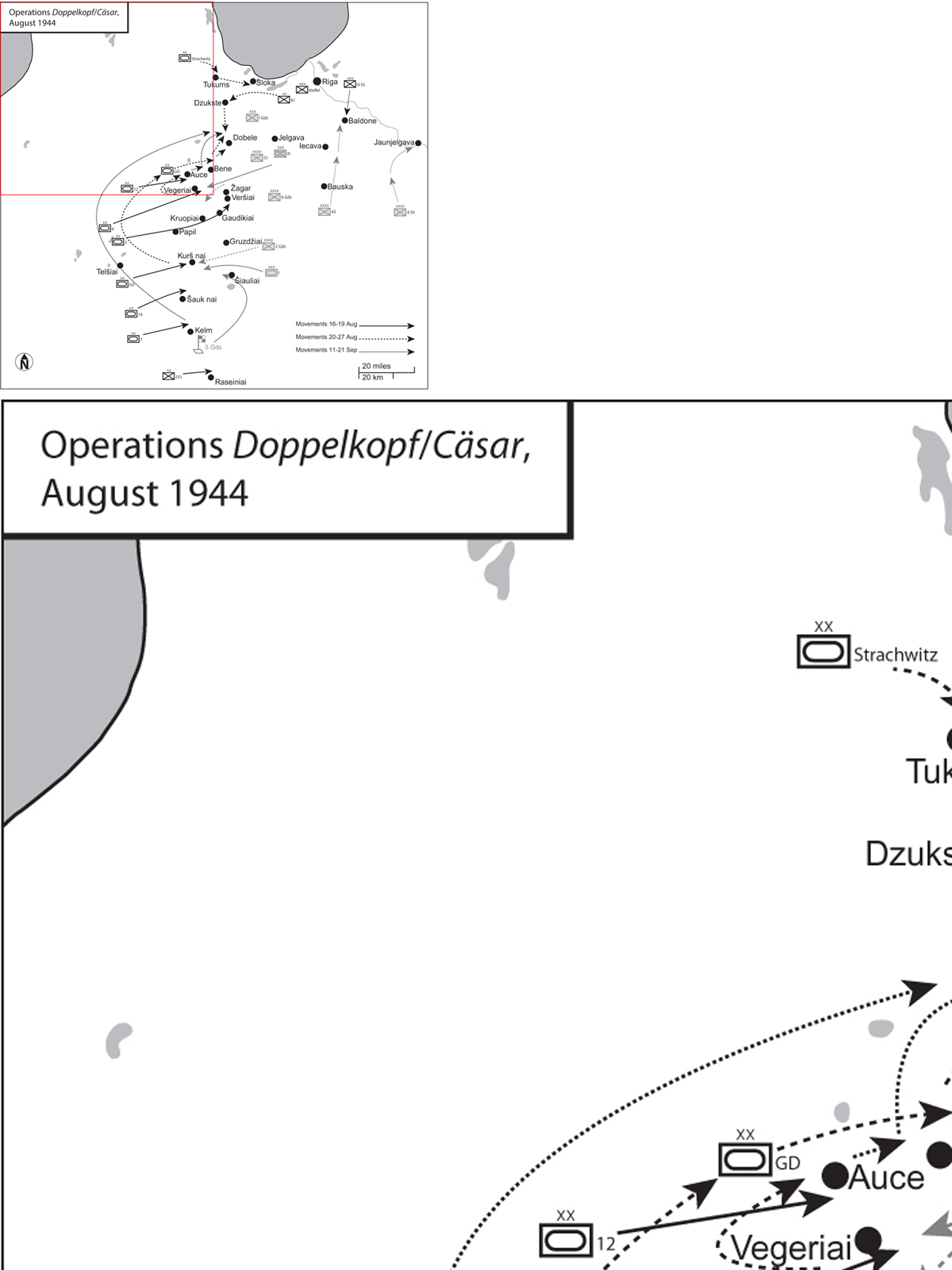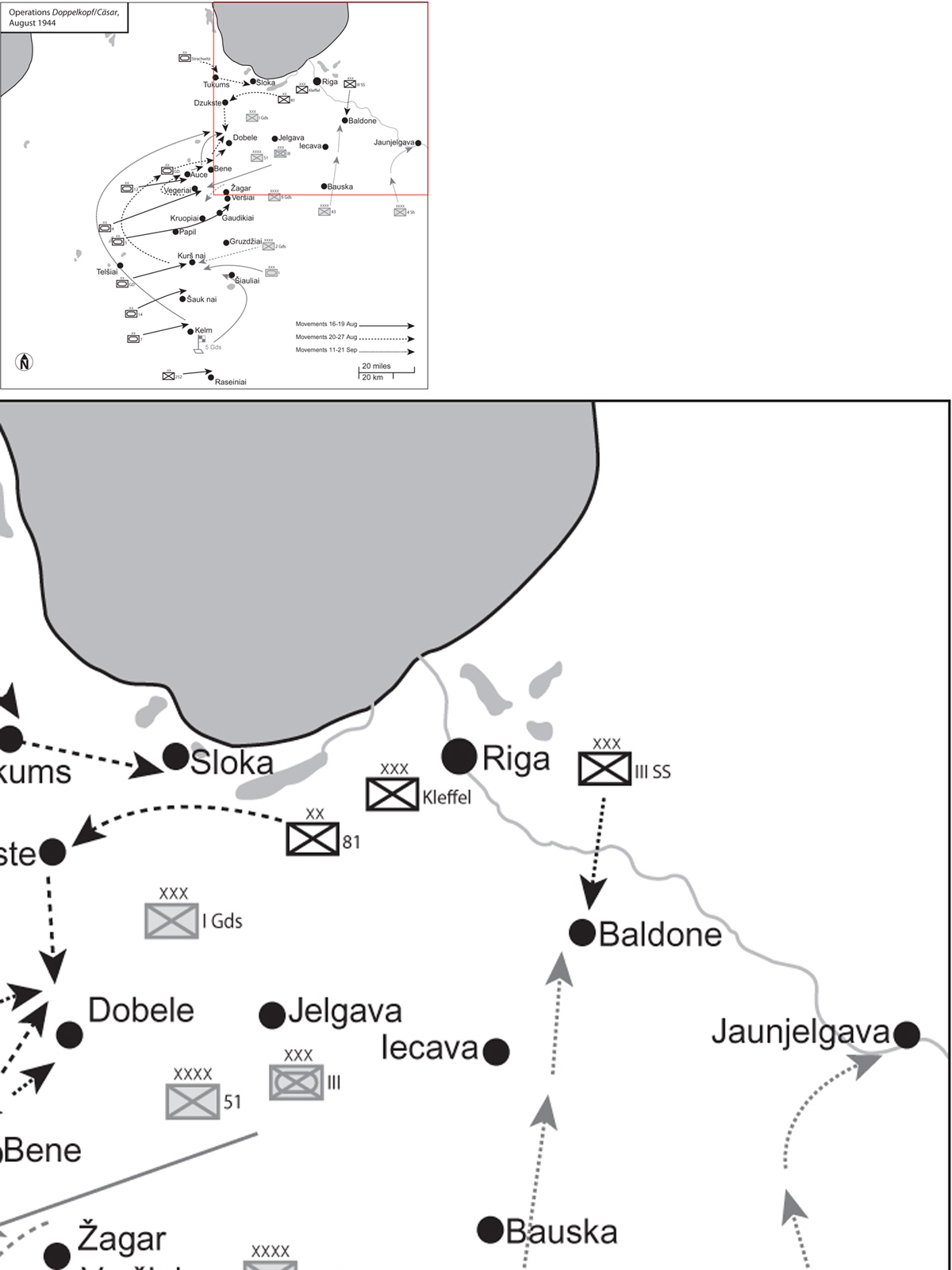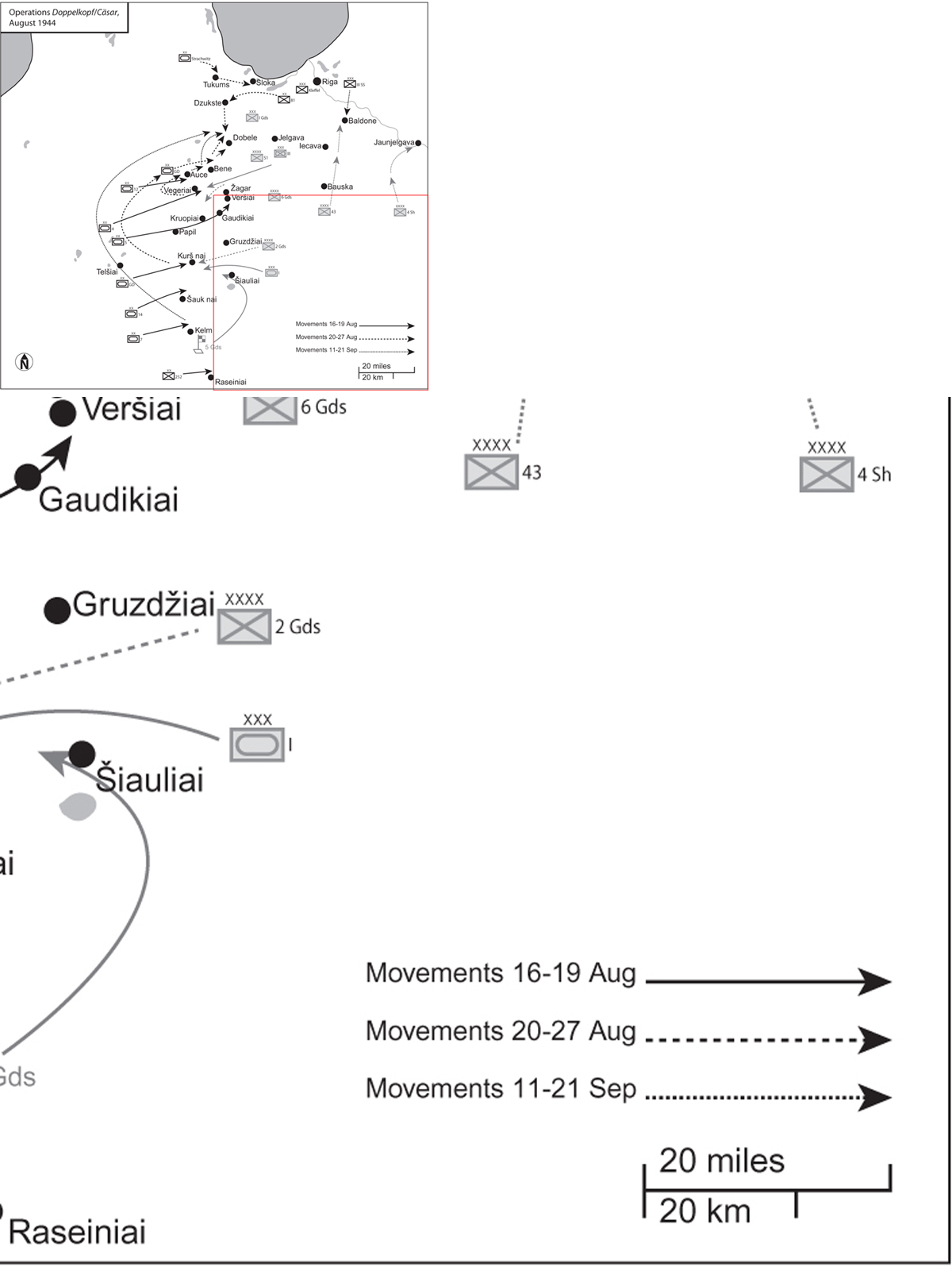Between Giants (40 page)
Authors: Prit Buttar
Tags: #Between Giants: The Battle for the Baltics in World War II

During their advance, Bagramian’s forces encountered the modest bands of pro-Soviet Latvian partisans, who provided intelligence on German troop dispositions. These reports suggested that German troops on the southern and western approaches to Riga were massing for a breakout; the reality was that 16th Army lacked sufficient armour to make any such attempt. In order to prevent such a breakout, Bagramian decided that, while 51st Army would take up a defensive posture in the face of the anticipated German attack from the west, 4th Shock Army and 43rd Army would prepare to launch an attack towards Riga. At the very least, this would disrupt German plans for a breakout.
On 14 August, the German IX Corps launched an attack with 252nd Infantry Division, reinforced by elements of 7th Panzer Division, immediately north of Raseiniai. The operation, codenamed
Greif
, was seen as a preparatory attack for
Doppelkopf
, and succeeded in taking most of the town. Over 60 Soviet tanks were reported knocked out, and 7th Panzer Division was extracted from the front line in preparation for the main operation. Late on 15 August, the divisions earmarked for the main thrust began to move from their forming up areas to the front line. As the troops wound their way along narrow roads, grim news from the west spread from man to man: the Western Allies had made an almost unopposed landing on the French Mediterranean coast. The difficulty of the task before them also became clear even before they reached the front line:
Everything was small, tiny copses, little hills, narrow roads, small bridges, drainage ditches and streams everywhere. In short, it was no country for armoured warfare, we could see that already after a few kilometres. Above all, the curvy, small roads and the bridges, which were too weak for our ‘heavy bears’, made things difficult for us. For sure, the combat engineers worked constantly and gave almost superhuman service, but still, here a ford proved unreliable, there a bridge collapsed under a heavy tank. Detours had to be reconnoitred, the columns constantly stopped before new obstacles. Where the tanks could still operate, it wasn’t possible for the fuel trucks to follow – and we desperately needed fuel with this constant driving. In the end, the 100km journey to our start line was achieved. But how many small acts of heroism had to occur during the dark of this night that would never be counted.
10
Doppelkopf
began on 16 August, a day earlier than 3rd Panzer Army had originally wanted. Despite the presence of five panzer divisions and a panzergrenadier division, the number of German tanks was disappointingly small – only 133 in XXXIX Panzer Corps, and only 148 in XL Panzer Corps. The weather, dry and sunny, was perfect for armoured operations. In the north,
Gruppe Gross
, which had pulled back from the outskirts of Tukums, made little progress in the face of determined resistance. With the allocation of 101st Panzer Brigade, still en route by sea, and assorted staff and communications elements, the group was somewhat grandiosely named
Panzer Division Strachwitz
. Further south, XXXIX Panzer Corps crossed its start line at 0800hrs. 4th and 5th Panzer Divisions were able to field substantial forces, and made good progress, but 12th Panzer Division still awaited the arrival of all its elements. 5th Panzer Division attacked in two battlegroups, and the southern one had to conduct an assault across the River Venta at Papilė, where it encountered heavy resistance and was forced to shift its point of attack, attempting to bypass the town to the south, as Alfred Jaedtke, commander of a panzergrenadier battalion, recalled:




The armoured group had only just overcome the most forward Russian elements in battle and had not yet penetrated the enemy’s lines adequately deeply, so the shift to the south meant that when marching past the town, it came under substantial anti-tank fire both from there [the Soviet forward positions facing west] and also in the left flank. This was the result of excellent directed fire from the Russian artillery …
There were still a few irritations from Russian anti-tank guns that were well-positioned in woodland about 6km north-east of Papilė. But the resistance was swiftly overcome. In the adjoining woodland (about 8km deep), we surprised a battalion of Russian artillery, a swift capture for our tanks. Weak enemy resistance in Mažūnaičiai was quickly crushed. On it went towards Kruopiai. Everywhere teemed with Russians, but there was never any meaningful resistance. It seemed they were from scattered units or rear area formations. The morale of our men was outstanding. After the numerous fighting retreats, we were at last advancing again, as in the old days.
11
Further south, XL Panzer Corps thrust forward with
Grossdeutschland
. Held up by poor roads, the division struggled towards Kuršėnai, where it was able to secure a crossing over the River Venta when it captured an intact rail bridge. A little to the south, 14th Panzer Division also seized a bridge over the Venta near Šaukėnai, but 7th Panzer Division ran into heavy resistance north-east of Kelmė.
With its armoured forces concentrated in a relatively small area, 3rd Panzer Army left other parts of the German front exposed to enemy attack. XXVI Corps on the southern wing of the army defended a substantial part of its line with the weak 549th and 561st Grenadier Divisions; relatively newly raised, these formations had a large proportion of men previously deemed unfit for front line service through age or infirmity, and lacked both a core of veterans and any combat experience. Even as
Doppelkopf
began, elements of the Soviet 11th Guards Army, 33rd Army and 5th Army attacked in this sector. 6th Panzer Division was able to put up good resistance, but was driven back, and the attacks achieved significant penetrations in the sectors held by the two grenadier divisions on the flanks of the panzer division. These advances were a direct threat to East Prussia, and had to be countered. Consequently, the 1st Infantry Division, en route for deployment in
Doppelkopf
, was diverted to help reinforce XXVI Corps.
Bagramian received reports of varying seriousness. On the one hand, the defences facing XL Panzer Corps seemed to have held up well, though they claimed to be facing attacks by about 250 German tanks, i.e. a number almost as great as the entire German armoured strength along all axes of attack, but on the other hand, the reports of armoured attacks by XXXIX Panzer Corps gave little indication of their strength or which German units were involved. By the end of the day, he had confirmation that 126th Rifle Division had been forced back by elements of
Grossdeutschland
and 7th Panzer Division. Vassilevsky advised the move of 5th Guards Tank Army to the Šiauliai area be accelerated, and Bagramian harangued the commanders of 51st Army and 2nd Guards Army to make greater efforts to identify the units that were attacking them, and to move all artillery assets to the front line to provide maximum support.
12
At dawn on 17 August, 4th Panzer Division assaulted Soviet defences around the village of Vegeriai, which had brought the previous day’s advance to an end. The village was taken swiftly, but attempts to push east made slow progress, due to a mixture of difficult terrain and determined resistance from well-positioned anti-tank guns. By the end of the day, the division had pushed forward barely three miles, though 12th Panzer Division made somewhat better progress to the north. 5th Panzer Division’s southern battlegroup succeeded in reaching Gaudikiai, but like 4th Panzer Division to the north, was held up by tough anti-tank defences. Two days of fighting had moved the front line forward perhaps nine miles.
Grossdeutschland
attacked and took the town of Kuršėnai, but 14th Panzer Division made little headway after its bridge over the Venta was damaged by artillery fire. Here, Bagramian’s order to deploy artillery in the front line had a marked effect, as he described in a style in keeping with most Soviet accounts of the era:
Colonel Pavlenkov’s 1187th Artillery Regiment had the hardest time. The gunners defended themselves to the last round. The crew of an anti-tank gun led by the communist Kustov alone sent five tanks, including two Tigers, up in flames. As German infantry with machine pistols approached the gun, they were engaged with hand grenades. Finally, only the gun-aimer Podgorny was left alive of the crew. Despite being wounded, he fired the last shell and then with the driver of the supply vehicle moved the gun to a safe location. Kostov and Podgorny were awarded the title Heroes of the Soviet Union by the Praesidium of the Supreme Soviet of the USSR on 24 March 1945.
13
7th Panzer Division suffered a major setback as it attempted to attack from Kelmė, as one of its officers recorded in his diary:
The attack was already in full flow. The battlegroup gathered in a large dip in the land during the afternoon. It was generally quiet. The armoured unit officers had just started a discussion in the commander’s half-track when an apparently stray sighting round exploded in the dip. Immediately after there was a second shot. By chance, this round detonated in the regimental commander’s half-track. All the men in the vehicle were killed (the commander, adjutant, signals officer, driver and radio operator). Consequently, the entire command of the division’s groundbreaking battlegroup was knocked out.
14
Oberstleutnant Weitzel, commander of the division’s 6th Panzergrenadier Regiment, was killed, as well as his adjutant and the adjutant of the division’s Panther battalion. Whilst open-backed half-tracks allowed panzergrenadiers to deploy easily, they were very vulnerable to plunging artillery fire, as 7th Panzer Division discovered at its cost.
In the midst of the ongoing fighting, there was another round of changes in the German command. Model was dispatched to take command of the Western Front, and was replaced as commander of Army Group Centre by Georg-Hans Reinhardt. Raus took command of 3rd Panzer Army.
From the Soviet perspective, the attack by XL Panzer Corps appeared to pose the greatest threat, though 51st Army reported that the forces attacking it – mainly 4th and 5th Panzer Divisions, though the Soviet forces had not yet identified them – consisted of ‘about 200 tanks and strong infantry formations’.
15
1st Tank Corps and 103rd Rifle Corps were dispatched to Šiauliai from 1st Baltic Front’s reserves. Although 5th Guards Tank Army was moving to the area, Bagramian was frustrated to learn that it had only 17 tanks ready for combat, in place of the 500 tanks he had expected. General Konsantin Skorniakov, commander of 1st Baltic Front’s tank and mechanised forces, responded by presenting the report of Major General Petr Kalinichenko, 5th Guards Tank Army’s chief of staff: